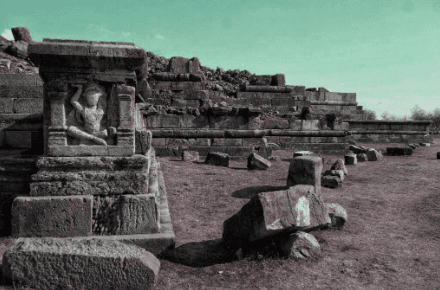Temple Architecture: Kashmir | History Optional for UPSC PDF Download
Introduction
Medieval Kashmir architecture began in the 7th century A.D. and continued until the transfer of power from Hindu to Muslim rule in 1337 A.D.
Two Main Types of Architecture:
- Medieval Kashmiri architecture is divided into Buddhist and Hindu architecture.
- Early temples were Buddhist, while later ones were Hindu.
Materials and Techniques:
- There is little difference in materials, ornamentation, and techniques between Buddhist and Hindu temples.
- However, the religious needs of the two communities led to significant differences in the plan and elevation of the temples.
Rulers and Their Contributions:
- Lalitaditya (724-760 AD, Karkota dynasty): Known for building both Buddhist and Hindu temples.
- Avantivarman (855-833 AD, Utpala dynasty): Founded the cities of Avantipur and Suyapur, and built Hindu temples dedicated to Vishnu and Shiva.
- Shankarvarman (885-902 AD, Utpala dynasty): Noted for constructing Hindu temples.
Influence of Buddhist Architecture

Influence of Buddhist Architecture on Hindu Temples in Kashmir:
- Buddhists, with their long artistic tradition, stuck to old models but used better materials and added more decoration.
- They used grey limestone, which was easy to carve and could be made very smooth.
- Buddhist architecture greatly influenced Hindu temples in Kashmir.
- Although Hindus didn't need to borrow stupas and sangharamas from Buddhists, they benefited from Buddhists' experience in temple-building.
- Both communities had similar needs:
- A chamber for installing a divine image (whether of the Buddha, Bodhisattva, Vishnu, or another Hindu deity).
- Space for worshippers.
- Parihasapura is the only surviving example of a Buddhist chaitya (temple). Its pyramidal roof influenced Hindu temples.
- Parihasapura was built by Lalitaditya and destroyed by Sultan Sikandar in the 14th century.
Wangath Temple Complex:
- The Wangath Temple complex is located in Wangath, Ganderbal district, Jammu and Kashmir.
- It was built in the 8th century AD by Lalitaditya Muktapida of the Karkota dynasty and is dedicated to Lord Shiva.
The main architectural features of the temples of the Kashmir
Evolution of Temple Architecture in Kashmir
- Progression: Kashmir's early temple architecture evolved from simple designs to more elaborate ones gradually.
- Orientation: Temples are typically oriented either east or west.
- Roof Design: Distinctive two-tiered, straight-edged pyramidal roofs, influenced by early Buddhist architecture, unlike the curvilinear roofs seen in southern Indian temples.
- Pediment: Pyramidal pediments with trefoil niches on all four sides of the main shrine.
- Cellular Layout: Unique cellular layout featuring rows of pillars, with some temples showcasing fluted pillars.
- Gateway: Double-chambered gateways that match the central shrine in scale and design.
- Garbha Griha: The principal part of the temple, with a pyramidal roof.
- Absence of Mandap: No mandap (pillared hall) is present.
- Ground Plan: Rectangular ground plan with temples situated within rectangular courtyards.
- Courtyard: Rectangular courtyards surrounded by walls with niche shrines.
- Lack of Curvilinear Shikhara: No tower (shikhara) is present.
- Pillars: Characteristic pillars with moulded bases and capitals.
- Materials: Temples often constructed from large, finely finished stone blocks, giving a megalithic appearance.
- Panchayatana Examples: Instances of Panchayatana style, similar to Nagara style, such as the Shiva temple at Avantipur.
- Example Temples: Notable examples include the temple at Pandrethan and others located in the center of shallow tanks.
Some examples of temples from the early medieval period include
1. Martand Temple by Lalitaditya:
- One of the earliest Hindu temples in Kashmir, known for its grandeur and craftsmanship.
- Built by Lalitaditya of the Karkota dynasty and dedicated to the sun god.
- Located on karewa land, the temple features a large courtyard with a cellular peristyle, originally supported by 86 fluted columns.
- The main structure includes a grabhagriha(sanctum),anatrala(ante-chamber), and a closed mandapa(hall), accessed by a grand staircase.
- The sanctum has a three ratha plan, and the quadrangular peristyle is one of the largest in Kashmir, with an impressive entrance.
- Constructed from large limestone ashlars, the Martand Temple is a significant monument of Kashmir.
2. Avantishvara Temple (Shiva Temple) and Avantiswami Temple (Vishnu Temple) at Avantipur by Avantivarman:
- Built by Avantivarman of the Utpala dynasty, these temples are of the panchayatana type.
- The temple gateway is double-chambered and lacks ornamentation.
- The main sanctum is elevated on a high platform.
3. Shankaracharya Temple near Srinagar by Lalitaditya:
- Another significant temple built by Lalitaditya in the region.
4. Shiva Temple near Srinagar by Shankaravarman:
- A temple dedicated to Shiva, built by Shankaravarman.
|
367 videos|995 docs
|
FAQs on Temple Architecture: Kashmir - History Optional for UPSC
| 1. What are the key characteristics of Buddhist architecture in Kashmir? |  |
| 2. How did Buddhist architecture influence temple architecture in Kashmir? |  |
| 3. What are the famous Buddhist architecture sites in Kashmir? |  |
| 4. How did geography affect the development of temple architecture in Kashmir? |  |
| 5. What role did patronage play in the evolution of temple architecture in Kashmir? |  |















